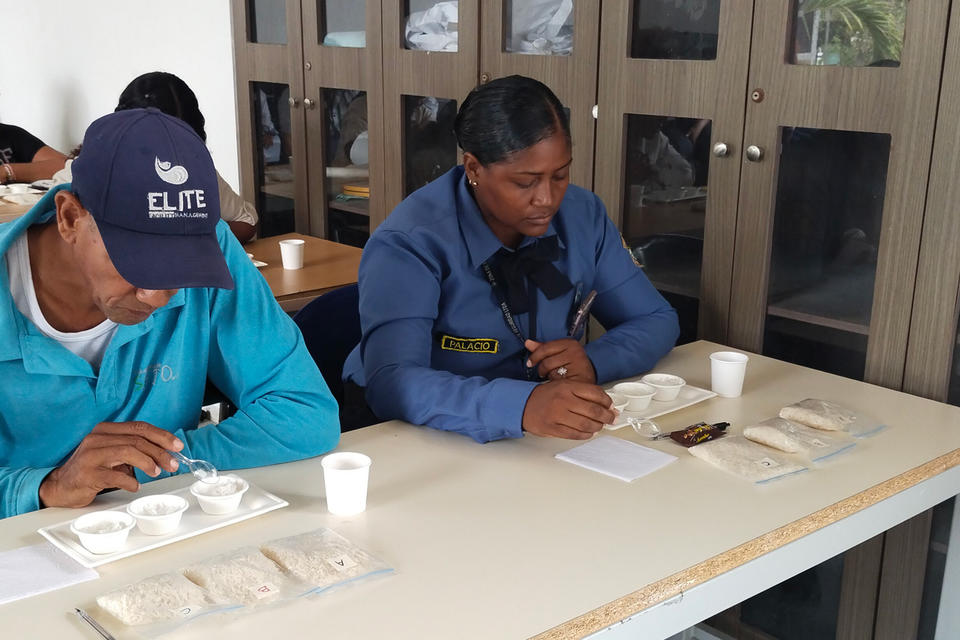Biofortified rice contributes to increasing micronutrient consumption. Are consumers willing to pay for this solution in Cartagena, Colombia?
- From
-
Published on
22.06.23
- Impact Area

In October 2021, Fedearroz BIOZn 035 – a zinc-biofortified rice variety – was officially released in Colombia. Born from the collaborative research work of CIAT (currently Alliance Bioversity-CIAT) and disseminated by Fedearroz, this variety has the potential impact on addressing micronutrient deficiencies due to its higher zinc content. For instance, 114g of biofortified rice consumption for an adult woman would contribute 24% of her daily zinc requirements, while commercial varieties only contributed a 16% – 50% increase in intake. In the case of children, 59g would contribute 27% of daily zinc requirements, while commercial varieties contribute only 18% (Woods et al., 2020).
Mainly, this variety was targeted at the Caribbean region of Colombia, where it is identified with a high probability of impact due to the zinc deficiency levels – affecting 41% of children (ages from 1 – 4) (ENSIN, 2015) and the intense rice consumption levels (the national average is 41kg per person per year).
Furthermore, in the region, a joint effort led by CIAT to scale up biofortified rice production in one of the most depressed departments of Colombia (Bolivar is in the top ten departments with higher poverty rates). Those farmers receive high-quality seed and extension services in collaboration with our partner Fundacion Canal del Dique. We aim to generate high-quality, sustainable products that can satisfy a specific market segment of consumers and improve the regional rice producers’ well-being.
Nevertheless, more than scale-up/production is needed. We need to connect from farm to fork. The demand side is determinant for achieving the potential impacts of this variety in increasing micronutrient consumption, and raises the question: are consumers willing to pay for biofortified rice? Will they substitute traditional rice? Consumers’ answers to these questions are relevant and can contribute to correct policy designs to improve micronutrient deficiencies while providing an attractive alternative for rice commercialization. Furthermore, it is an input for breeders to identify new market segments and possible traits to be considered for improving biofortified varieties acceptance.
To answer those research questions, CIAT (current Alliance Bioversity-CIAT) and Arkansas University joint efforts to apply a commercial feasibility study for this rice variety in Cartagena city, one of the principal cities in the region and likely market for the product, we selected the methodology of the experimental auction to measure the value that consumers give to biofortified rice.
Auctions were applied in May 2023 to 400 people in Cartagena with the collaboration of SENA and Canal del Dique Foundation. Participants tasted biofortified rice in each one and were offered a price under experimental conditions that revealed their willingness to pay. We have learned that consumers value biofortified rice differently depending on the amount of information provided to them. The experiment makes them respect distinct types of rice without knowing the samples. They recalculate their offered prices by providing them with information about each model (like the type of rice or the biofortified benefits).
Related news
-

Next-gen rice lines top check varieties at 7.5 t/ha in ESA
International Rice Research Institute (IRRI)11.11.25-
Food security
MOROGORO, Tanzania (8 October 2025) — Elite rice lines are outperforming the current popular varie…
Read more -
-

QTL Profiling Now Live on EBS
International Rice Research Institute (IRRI)11.11.25-
Food security
QTL profiling is now integrated into the EBS Platform’s MDA module. Teams across CGIAR research…
Read more -
-

Trust before change: Inside Thailand’s rice farming communities
International Rice Research Institute (IRRI)07.11.25-
Food security
By Christian Dohrmann This year, Thailand and the International Rice Research Institute (IRRI) have …
Read more -
